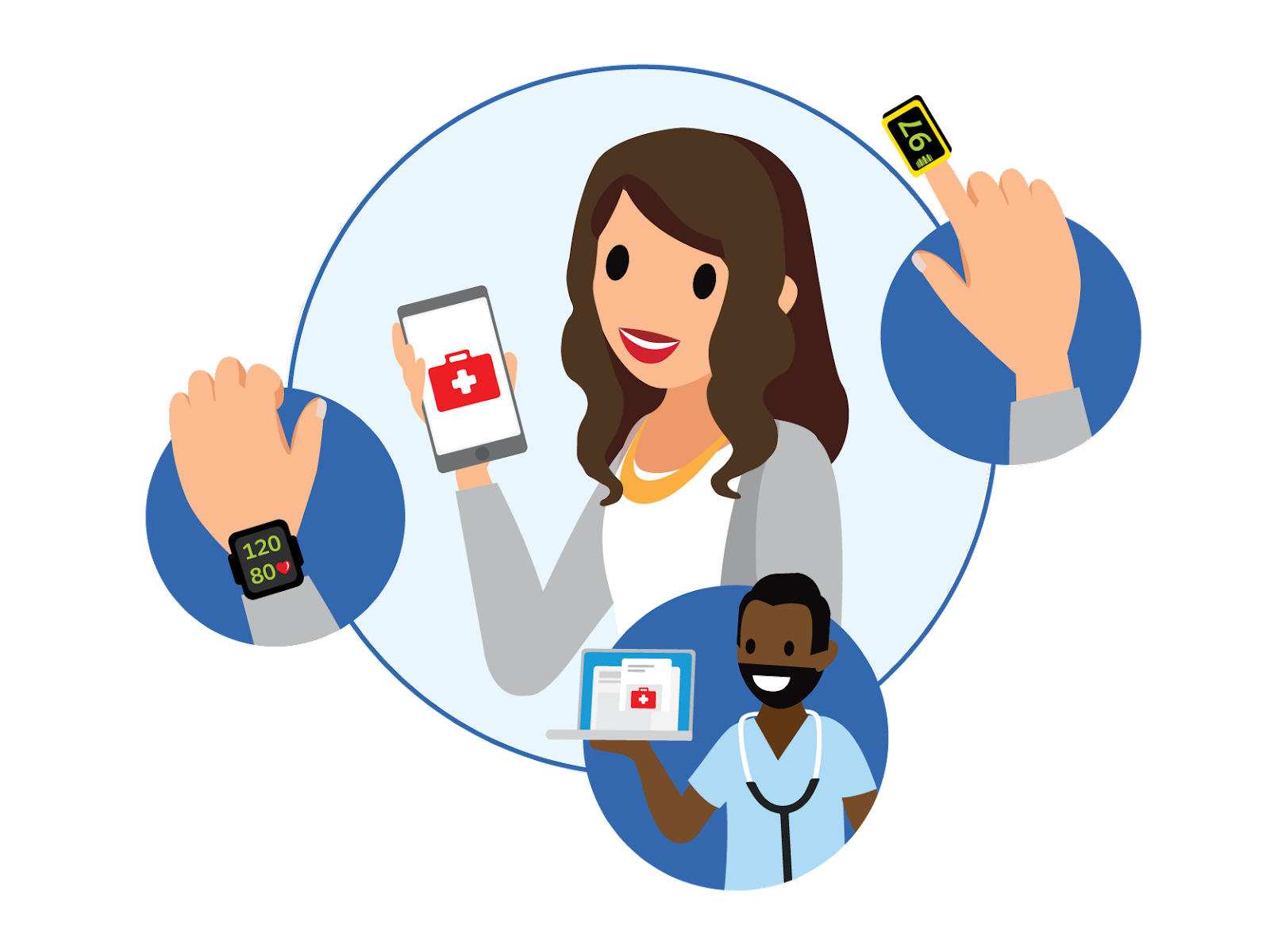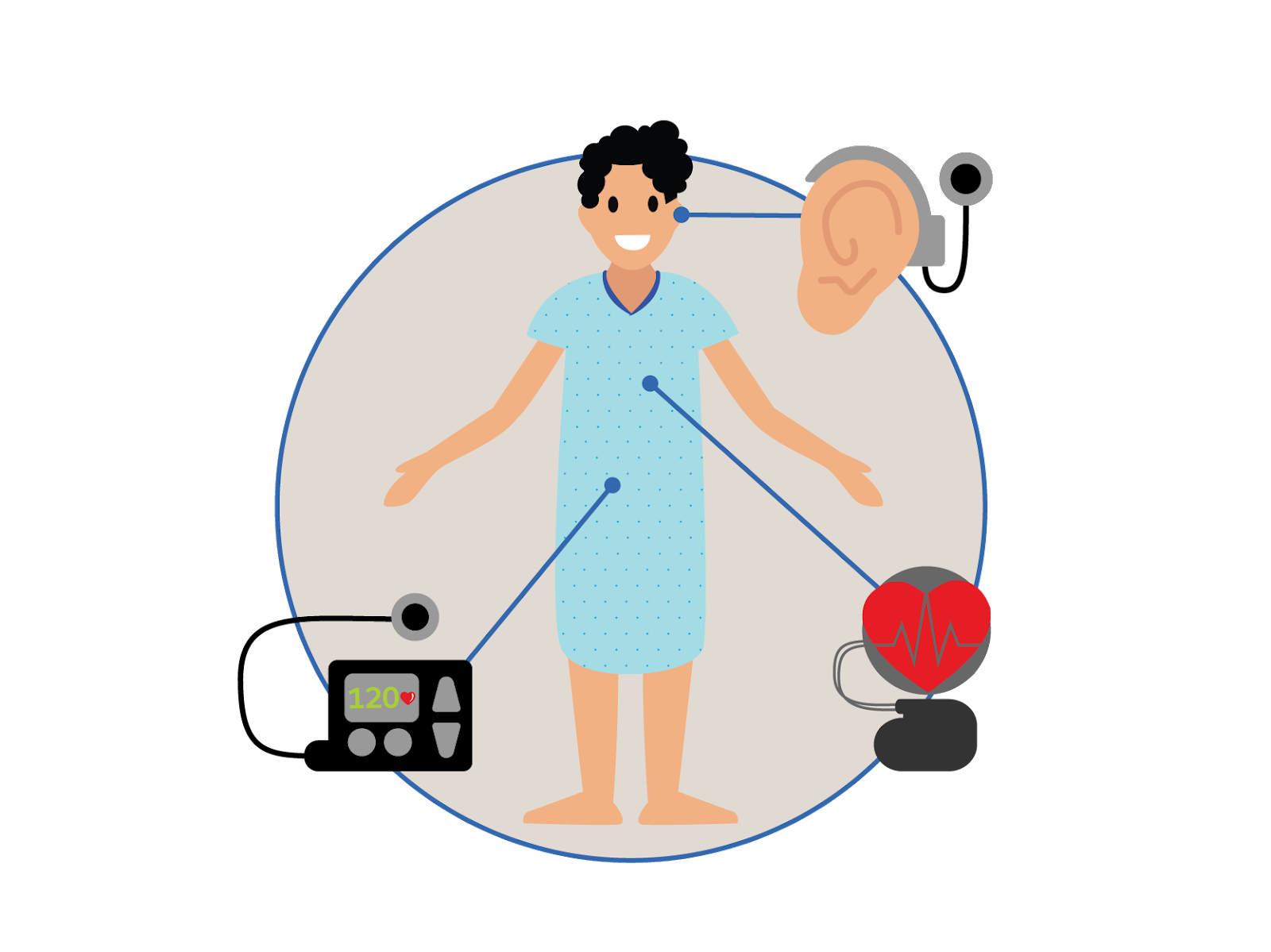Describe the Healthcare Technology Landscape
Learning Objectives
After completing this unit, you’ll be able to:
- Describe the healthcare technology landscape.
- Identify the main goals of healthcare industry organizations.
- Define key healthcare technologies.
- Define key cybersecurity terms used in the healthcare industry.
What Is Healthcare Technology?
Most people use healthcare technology (healthtech) every day even if they don’t know it. From wearable devices such as smartwatches that track heart rate to the Internet of Things (IoT) to track insulin levels in diabetes patients, healthtech’s use is widespread and continues to grow at a rapid pace. But what is healthtech and why is it important?
Healthtech is the use of technologies developed for the purpose of improving all aspects of healthcare. These technologies include digital devices, software, and tools designed to support healthcare organizations, doctors, and patients, with the goal of enabling people to access, exchange, and manage healthcare information electronically.

Healthtech improves patients’ quality of care by increasing the productivity and efficiency of hospitals and other healthcare organizations. By turning over recurring and monotonous tasks to powerful computers, the technology lessens the burden on healthcare professionals and allows them to focus their goals on improving healthcare for all.
Goals of Healthcare Organizations
When it comes to quality healthcare, there’s no one-size-fits-all approach. In fact, personalization and customization are key as no two people are alike. Tailoring everything from medication to exercise regimens amplifies human health. Healthtech is such a transformative practice that its impacts are causing a lasting change across the globe.
In general, healthtech aims to:
- Improve the patient experience.
- Improve people’s health.
- Reduce the per-person cost of healthcare.
Healthtech supports these aims by expanding options for medical treatments while transforming how medical professionals execute their jobs. It also provides patients with tools for managing their health independently and together with their healthcare practitioners.
As an enabler of the medical profession principle, “First, do no harm,” healthtech introduces new technologies that, when properly secured, increase patient health by reducing medication errors and improving compliance. For example, pharmacists can use healthtech to improve patient safety by identifying prescription drug conflicts through data correlation of a patient’s allergies with prescribed medications. Healthcare practitioners can use healthtech to access and update patient health records and exchange patient care data with colleagues rapidly for collaboration efforts, secondary opinions, and evaluations.
Key Healthcare Technologies
Healthtech is already becoming integrated into every fabric of the healthcare industry from administrative processes to cancer research and drug development. Healthcare practitioners can leverage these technologies to make the patient experience as painless as possible while improving overall human health. Let’s take a closer look at some healthtech applications in the areas of administrative processes, drug development, surgery, IoT, and telehealth.
Administrative Technologies
Administrative technologies allow hospitals and healthcare organizations to manage their growing administrative workloads and tasks such as scheduling and documenting patient care. Let’s look at a few of these technologies.
-
Artificial intelligence (AI) streamlines patient workflows by calculating wait times and predicting peak busy hours thus enabling improved scheduling and prioritization of appointments.
-
Electronic medical records (EMR) emulate a patient’s paper chart and contain the patient’s medical and treatment history from one medical practice into a digital version.
-
Electronic health records (EHR) contain the totality of a patient’s health record, consist of the patient’s EMR from multiple doctors, and represent a long-term view of a patient's health in digital form.
Drug Development Technologies
The pharmaceutical industry leans heavily on AI and machine learning (ML) to power a new wave of drug research and development by automating manual tasks such as combining certain chemicals to create the optimal drug.
Surgical Technologies
Surgical and recovery times are drastically reduced thanks to numerous technologies. Let’s look at a few common applications.
-
Robotics removes the dependence of solely onsite doctors for care. Robotic surgical assistants are often used in tandem with an onsite doctor to perform processes from non-invasive procedures to open-heart surgery.
-
Virtual reality (VR) allows aspiring surgeons the use of augmented VR (a real-life view of an experience projected onto a screen) to gain experience on conducting several different types of surgeries or practicing new surgical techniques.
-
Three-dimensional (3D) printing increases the number of available organs for transplants. 3D printing is changing the world of organ transplants by allowing for the substitution of certain organs and artificial tissue with 3D printed solutions to replace or repair damage or structures in the body.
- AI algorithms process imaging data to identify anomalies and suggest optimal surgical paths, reducing preoperative delays.
- Smart sutures and staples integrate sensors to monitor healing progress and alert clinicians to potential issues like infections.
IoT Technologies
IoT consists of a network of internet-connected objects able to collect and exchange data. The technology offers new opportunities for healthcare professionals to monitor patients, as well as patients to monitor themselves. Some examples of these health monitoring devices include connected inhalers and glucose monitoring.
-
Connected inhalers help treat conditions such as asthma by monitoring a patient's frequency of attacks and collecting environmental data for their healthcare provider to understand what triggered the attack. These inhalers also alert patients if they leave inhalers at home or when they use the inhaler improperly.
-
Glucose monitoring in diabetic patients has traditionally been difficult. Patients have to manually check and record their glucose regularly often at inconvenient times. These checks typically represent a snapshot in time. IoT devices for glucose monitoring provide continuous, automatic monitoring of glucose levels and eliminate the need for manual record keeping, while alerting patients when their glucose levels are problematic.
Remote Patient Monitoring and Telehealth
These are probably the most common applications of healthcare IoT devices. These devices automatically collect health metrics such as heart rate, blood pressure, or temperature from implanted or wearable medical devices from patients not physically present in a healthcare facility. Software applications manage, save, and forward the collected data to a medical professional anywhere in the world where an internet connection and access to the application exist.

Healthcare Cybersecurity Terminology
With all these advancements in healthtech, cybersecurity has become more vital than ever for the healthcare sector. Yet cybersecurity threats to the healthcare industry are rapidly on the rise. Financially motivated criminal organizations and other threat actors continue to target the healthcare industry with ransomware attacks and data theft, which puts patient safety and privacy at risk. It’s therefore critical to view cybersecurity as a patient safety issue, enterprise risk, and strategic priority. Before we dive a bit deeper into these threats and risks, let’s learn about a few cybersecurity related terms specific to the healthcare industry.
Term |
Definition |
|---|---|
Protected health information (PHI) |
The demographic information, medical histories, test and laboratory results, insurance information, and other data that a healthcare professional collects to identify an individual and determine appropriate care |
Medical device hacking (Medhacking) |
The practice of manipulating or disrupting a network-enabled medical device with the intent to gain unauthorized access to the device or data it stores. |
Medical device hijacking (Medjacking) |
A more malicious form of medhacking where cybercriminals hijack medical devices to take control of the device’s functions and manipulate its operation to cause harm to the patient, disrupt healthcare operations or other malicious purposes. |
Medical device security |
The cybersecurity measures used to protect medical devices (e.g., pacemakers, insulin pumps) from unauthorized access, modification or disruption. |
Health Insurance Portability and Accountability Act (HIPAA) |
A US law that protects individuals' health information while allowing for necessary access. |
Health Information Technology for Economic and Clinical Health (HITECH) Act |
An act that expands HIPAA by adding breach notification requirements. |
A nonprofit organization and voluntary certification and cybersecurity framework that helps healthcare organisations comply with HIPAA and HITECH. |
Knowledge Check
Ready to review what you’ve learned? The following knowledge check isn’t scored—it’s just an easy way to quiz yourself. To get started, drag the description in the left column next to the matching term on the right. When you finish matching all the items, click Submit to check your work. If you’d like to start over, click Reset.
Great work!
Sum It Up
You now have a better understanding of the role healthcare technology plays in patient care. In Unit 2, you learn about some of the cybersecurity threats to the healthcare industry, common threat actor tactics, and how you can protect healthcare technologies.
Resources
- External Site: International Business Machines Corporation (IBM): What is healthcare technology?
- External Site: Health Insurance Portability and Accountability Act of 1996 (HIPAA) Journal: Healthcare Cybersecurity
- External site: Health-ISAC: Partnered Report: Healthcare Cybersecurity Benchmarking Study 2024